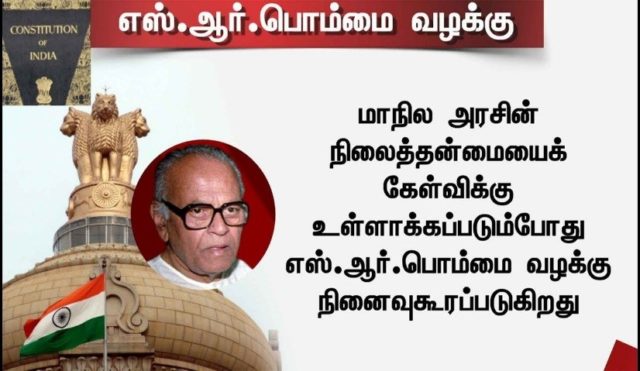PREVIOUS
S.R.Bommai Case
February 4 , 2019
2122 days
10675
0
Who was S.R. Bommai?
- R. Bommai was the Chief Minister of the Janata Dal government in Karnataka between August 13, 1988 and April 21, 1989.
- His government was dismissed on April 21, 1989 under Article 356 of the Constitution and President’s Rule was imposed.

- The dismissal was on grounds that the Bommai government had lost majority following large-scale defections.
- Then Governor P. Venkatasubbaiah refused to give Bommai an opportunity to test his majority in the Assembly despite the latter presenting him with a copy of the resolution passed by the Janata Dal Legislature Party.
What happened then?
- Bommai went to court against the Governor’s decision to recommend President’s Rule. First, he moved the Karnataka High Court, which dismissed his writ petition. Then he moved the Supreme Court.
What did the Supreme Court do?
- On March 11, 1994, a nine-judge Constitution Bench of the Supreme Court issued the historic order, which in a way put an end to the arbitrary dismissal of State governments under Article 356 by spelling out restrictions.
What did the judgement say?
- The verdict concluded that the power of the President to dismiss a State government is not absolute.

- The verdict said the President should exercise the power only after his proclamation (imposing his/her rule) is approved by both Houses of Parliament.
- Till then, the Court said, the President can only suspend the Legislative Assembly by suspending the provisions of Constitution relating to the Legislative Assembly.
What happens if the Presidential proclamation is not approved by the Parliament?
- In case both Houses of Parliament disapprove or do not approve the Proclamation, the Proclamation lapses at the end of the two-month period. In such a case, the government which was dismissed revives.
- The Legislative Assembly, which may have been kept in suspended animation gets reactivated.
- Also, the Court made it amply clear that a Presidential Proclamation under Article 356 is subject to judicial review.
What is the significance of the S.R. Bommai vs Union of India case?
- The case put an end to the arbitrary dismissal of State governments by a hostile Central government.
- And the verdict also categorically ruled that the floor of the Assembly is the only forum that should test the majority of the government of the day, and not the subjective opinion of the Governor, who is often referred to as the agent of the Central government.
When was the verdict’s impact was first seen?
- In one of the first instances of the impact of the case, the A.B. Vajpayee government in 1999 was forced to reinstate a government it dismissed. The Rabri Devi government, which was sacked on February 12, 1999 was reinstated on March 8, 1999.

- And later whenever the case of a hung Assembly, and the subsequent exercise of government formation, came up, the Bommai case would be cited, making it one of the most quoted verdicts in the country's political history.
-------------
Leave a Reply
Your Comment is awaiting moderation.


